Learn to make and maintain your own homemade bread starter from scratch with step-by-step instructions. This Yeast Starter Recipe takes only 3 simple ingredients and will have you baking your own Artisan Style Sourdough bread, and so much more, in no time!
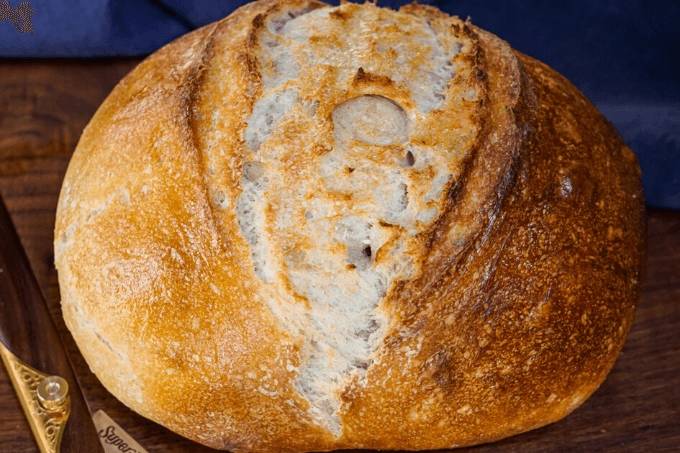
Bread starter is mystifying. How can flour and water become a culture that creates a beautiful loaf of bread with a soft crumb and the perfect crispy crust? This step-by-step tutorial will take the mystery out of yeast starters so pull out your apron and let’s get started!
What do you need to bake an Artisan style loaf of bread?
- A vigorous Starter
- A developed Levain
- Proofed dough
- Baking
Even though the steps are few, you can’t make homemade bread by skipping any of them.
When I finally convinced myself that I wanted to bake sourdough, I poured over articles and videos. The more I read the more freaked out I got!
I actually purchased a bread baking series that was supposed to help me make my own starter and bake some amazing bread.
Then I meticulously followed the instructions for making my own bread starter. I didn’t have any luck which really messed with my bread-baking psyche!
That recipe had you replacing a lot of the “seed” starter before it even got a chance to get going. It also used only all-purpose flour. This starter will give you a much better chance of success!
What is Bread Starter?
Bread starter is a combination of flour and water that mixes with wild yeasts and bacteria that are naturally found in the flour, air, and even your hands to form a culture.
This culture feeds on the natural sugars in the flour and must be fed regularly to prevent the depletion of the sugar supply. If you hear the term starving your starter, it means your starter has a lack of sugar to feed on.
This is especially important while you’re building your starter. Once you have a strong and vigorous starter if you skip a feeding don’t fret. Just get back on track.
Too many skipped feedings will throw off the microbial balance and lead to inconsistent results. See my tips on storing your starter below.
What’s the difference between a bread starter and a sourdough starter?
Many bakers call their starter a Levain or Starter. The characteristics and flavor of the bread is dependent on ingredients, method, time, temperature, shape, and technique.
A thicker Levain or longer proof can help produce the tang or sour flavor commonly associated with sourdough bread recipes.
Bread Starter Ingredients:
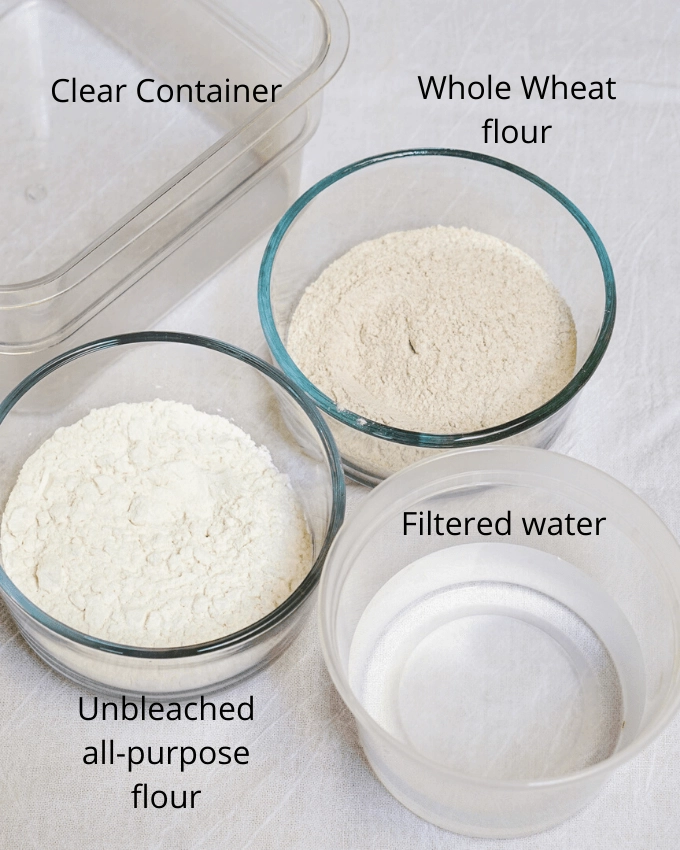
- Flour – You can use any flour. I use an equal mix of wheat flour and unbleached all-purpose flour. Whole grain flour such as wheat and rye have more nutrients and microorganisms than all-purpose flour. The yeasts and bacteria consume rye flour or whole wheat flour more quickly than others.
- Water – I use filtered water. It’s said that chlorinated water and water that has a high mineral count (hard water) can inhibit yeast growth. Also, use slightly warm or room-temperature water. Using cold water will slow the growth down.
How to make a Bread Starter
Use a non-reactive clear container such as glass or food-grade plastic. You want to be able to see through your container so you can monitor the progress. I recommend a container that is approximately 1 quart. Your starter needs room to rise.
You will also want to use a food scale that measures in grams. Why? Ingredients are added by weight not volume. You could measure out 1/4 cup of starter several times and never get the same weight because of the gasses it contains. Also, flour weight can differ according to how you fill a measuring cup or the measuring cup itself.
You can convert my measurements in the recipe below but if you have any difficulties making your yeast starter, the first thing I’ll ask is “did you weigh your ingredients”?
Ok, let’s get started!

- Combine 180 grams of filtered water and 90 grams of Whole Wheat flour and 90 grams of Unbleached All-Purpose Flour. Mix it with your hand until no flour remains visible. Your mixture will be like a thick sticky batter. *Cover the container and let it sit at room temperature in a shaded spot for 2 days. Check for bubbles around the sides and on the top. If there are just a few let it sit for another day.
- Once bubbles appear, you will notice that your starter stinks and that’s normal.
- Discard about 80% of the starter and add 100 grams of filtered water and 50 grams of all-purpose flour and 50 grams of whole wheat flour. Mix again by hand. Cover and let it sit for 24 hours. *You don’t need to wash out the container between feedings.
- Maintenance feeding is actually training your starter into a lively and predictable starter and that’s what you’re now doing.
- Discard about 80% of the starter and add 100 grams of filtered water and 50 grams of all-purpose flour and 50 grams of whole wheat flour. Mix again by hand. Cover and let it sit for 24 hours. *You don’t need to wash out the container between feedings.
- Continue discarding all but about 20% of the starter. Add 100 grams of flour (50/50 mix) and 100 grams of filtered water every 24 hours at approximately the same time of day, preferably morning.
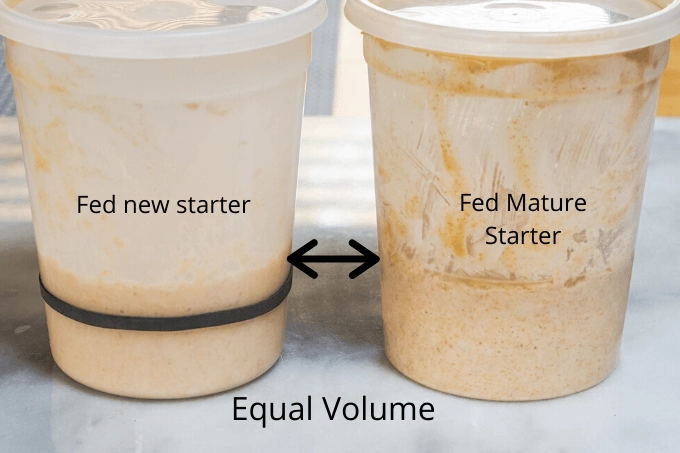
*Some people believe that you should loosely cover your starter with a dishtowel or light cloth so it can breathe. I’ve always covered mine with a lid and the only problem I’ve had is if the container was too small. My starter will actually blow the lid off!
While I was building my starter, I put a rubber band around the container to monitor its progress. You can also just make a line where your starter begins and follow it throughout the day.
Be Patient – Building a starter can take up to 14 days if not longer.
Once the yeast and bacteria are established, you will notice that the volume increases several hours after feeding and then collapses. The aroma also becomes milder and sweeter. At 8 hours my starter more than doubles.
It’s normal to take less time or more time depending on the temperature of your kitchen, the flour your use and the culture itself.
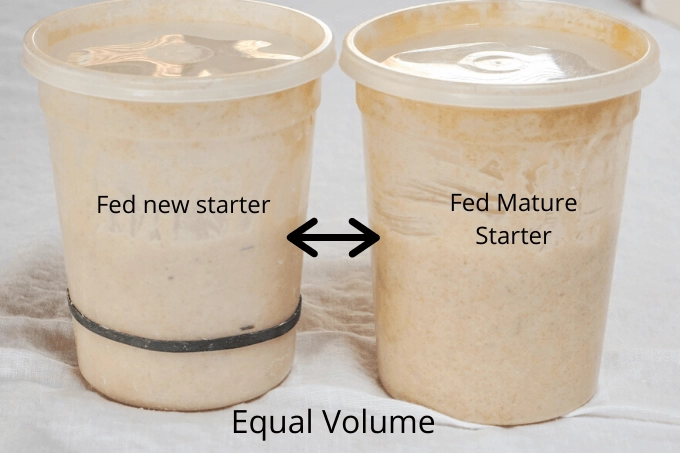
Once the yeast starter starts rising and falling predictably, you’re ready to bake your first loaf of bread!
I used this starter 10 days after making it.
10 days worked with my baking schedule. It was rising predictably closer to 8 days.
How to maintain and store your Bread Starter
If you plan to bake several times a week, leave the bread starter out at room temperature. Continue discarding and feeding every 24 hours.
There are variables that affect your yeast starter. Temperature is a big one. Cool temperatures will slow your starter down. Hot weather will speed up your starter and you may have to feed it more often.
If you will not be baking regularly, after you feed your starter, put it into the refrigerator. Discard all but a couple of tablespoons and feed it weekly. Continue using 100 grams of water and 100 grams of the flour mix.
You may notice a gray film or a liquid form over the top. Especially if you’ve ignored it for more than a week (guilty). That is commonly called Hooch. You can remove it but I just stir it back in. It doesn’t hurt a thing.
When you plan on baking remove the starter from the refrigerator and let it return to room temperature. Discard and feed your starter recipe again. I will do this for 2 to 3 days to get it good and vigorous again. If it seems sluggish feed it twice a day (every 12 hours).
I often bake on Monday or Tuesday so I will remove my yeast starter from the refrigerator on Friday and start feeding it regularly.
Bread starter is resilient. You can kill it from neglect but not very easily. Most often you can activate it with normal feedings. The exception is if it becomes moldy. Time to throw it out and make a new one. Hopefully, you have a little starter flakes in the freezer?
Can I freeze Bread Starter?
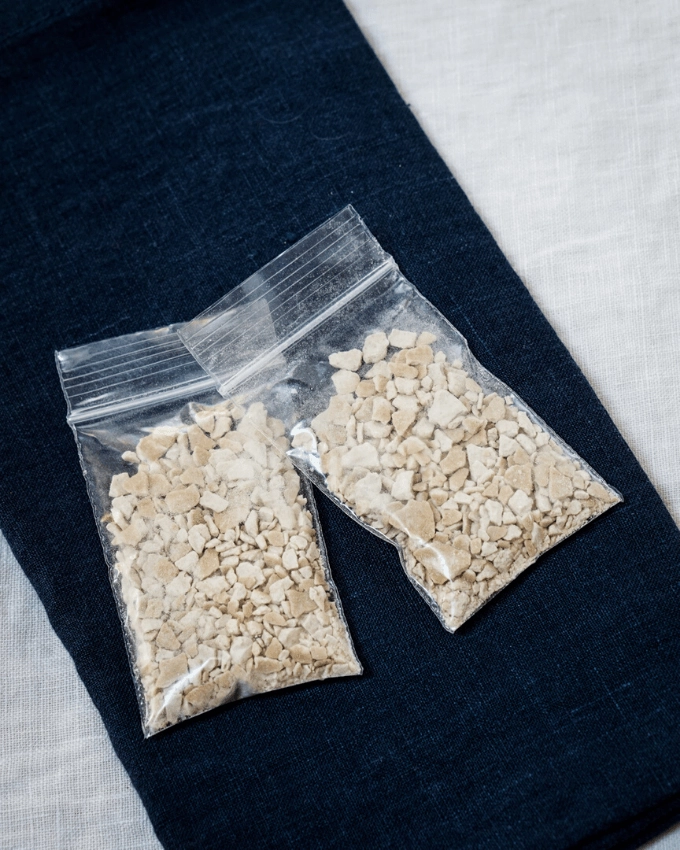
Starter Insurance – I was so fearful that I would kill my first starter that I smeared it on waxed paper and let it dry. Once dried I peeled it off the waxed paper then crushed it up in my mini-food processor. I froze it in tablespoon-sized packets.
I’ve made new starters using the crushed starter and it worked like a charm. Here is are printable instructions on using starter flakes to make a new starter.
I’ve heard you can freeze a liquid starter but I’ve never done it.
Using your starter
Before you bake with your starter, you want to make sure it is vigorous. If it’s been in the refrigerator, remove it from the refrigerator and feed it within 4 to 6 hours before you want to mix the Levain. If it raises well, I’ll mix my Levain before I go to bed.
A sluggish starter needs to be fed for another day or two or feed it twice in 12-hour intervals the day you remove it from the refrigerator. On the second day feed it in the morning and mix your Levain the night before you want to mix your dough.
I’ll generally mix my Levain around 9 o’clock in the evening and make sure that I use it by 9 o’clock the next morning even though I probably have a little more time than that.
You want to use your Levain within 2 hours of when it’s ready so it’s not going into starvation mode when you start mixing your dough.
A new starter will get stronger and stronger as it matures. I found even though I continued to feed my new starter the same as my existing starter, it was a little thinner than my mature starter. I guess we all get better with age right?
It also smelled a little more acidic but when it was time to bake with it, I couldn’t detect the difference in the baked bread.
Do I need a different Yeast Starter Recipe for different types of bread?
No, you do not. This Starter recipe can be used for any bread recipe that calls for a natural or wild yeast starter.
Some recipes may state that you need to feed your starter or make your Levain from the flour in the bread such as Rye or Pumpernickel. That’s not necessary. Just use the ratios of flour (50/50 mix) to water as they suggest.
If you want San Francisco Sourdough bread why not just buy their starter?
You can find a lot of San Francisco starters for sale. However, unless you continue feeding it with the same water and flour they used to make it, it’s not going to be a San Francisco starter for very long. It will take on the characteristics of the water and flour you use.
What is Levain, or Leaven?
Building a Levain is adding volume to a yeast starter.
NOTE: Levain and Leaven is the same thing.
Your bread dough usually needs more starter than you keep when you’re feeding your bread starter in order for the dough to rise. We build it by adding more flour and water. So, Levain is a fancy word for more starter.
When you are maintaining a starter, you don’t have to keep as much as is called for in most bread recipes that use a natural yeast starter. Keeping a lot more than you need is a waste of flour.
For that reason, we build on our vigorous starter so we have enough for the bread recipe. That’s called a Levain. Any leftover Levain becomes our new starter so we want to make sure that we have enough leftover.
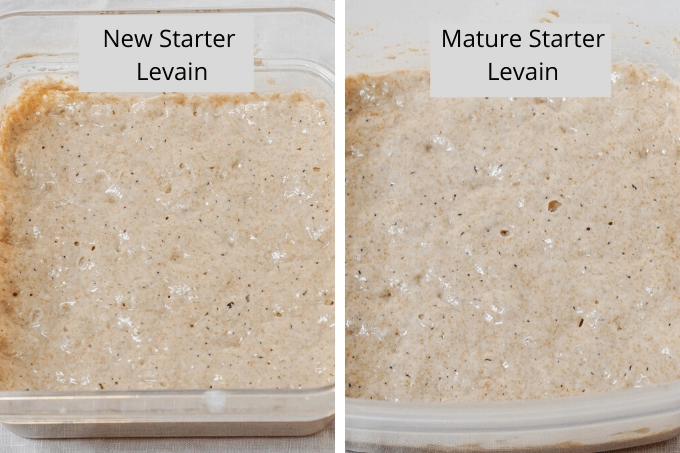
How do I know how much Levain to make?
The recipe will usually tell you how much you need. They may say starter but it’s the same remember?
If your recipe calls for 150 grams of Starter or Levain, the night before I will mix up 1 tablespoon of my mature starter, 150 grams of filtered water, and 150 grams of my flour mix.
After I measure out the amount of starter (Levain) that I need to mix my dough, I will take a tablespoon of my Levain for my maintenance starter and feed it with the filtered water and flour mix.
Let it sit out at room temperature for about 30 minutes and then refrigerate it if you’re not going to be baking with it right away.
How do I know if my Levain is ready to use?
Once you mix up your Levain, let it sit for about 8 hours. Most of the time I’ll mix up my Levain before I go to bed and then the next morning mix my dough.
Put a small amount of water in a bowl and do a float test. Drop some Levain into the water. If it floats it’s ready. Levain is aerated by wild yeast activity that produces carbon dioxide making it float.
If it doesn’t float cover it and place it in a warm place 73°-75°F for another 30 minutes and test it again. Ultimately, if it doesn’t work discard half the Levain, add 100gr warm water and 100gr flour mix. Cover it and set it in a warm area for 2 hours and then retest it again.
If your Levain is thin, it could be because you allowed the starter to ferment for too long before trying to use it, you will have to feed it again before you can use it.
Tip: To create a warm environment I will often briefly heat up a cup of water in the microwave and then put the container containing the Levain in the microwave where it’s warm and moist. You don’t want it too hot, however. You can also just turn the light on in your oven and set it in there.
Many bakers will use a “proof box” which maintains a constant temperature for your starter and dough. I use my microwave like a proof box.
Troubleshooting and FAQ’s
Question – “I followed the recipe to a T, but when I woke up, the dough was completely liquified… I’m not sure what I did wrong, but it was more like melted ice cream than dough.”
Answer – Most likely your starter is starving and not strong enough to bake with. If you’ve neglected it or it’s been stored in the refrigerator for an extended time, feed it every 12 hours. It should be doubling in volume and collapsing predictably with plenty of strong bubbles before you use it.
To get it going again refortify it with several feedings of 20% starter, 100 grams of the flour mix, and 100 grams of filtered water. You want all of your ingredients to be at room temperature.
Question – My starter used to be vigorous but now it’s having trouble gaining strength.
Answer – Don’t worry, it happens.
Try feeding it twice a day for a couple of days before you want to use it.
You can also use some whole-grain rye flour to feed your starter. Rye contains certain yeasts that are prolific in fermenting. Remove about 1 tablespoon of all-purpose flour and add back an equal amount of rye.
Whole grain flours can accelerate fermentation and will have your starter ready to go in a couple of days. When it’s strong again you can resume feeding it with the flour mix.
What you may need to make this Bread Starter Recipe:
Kitchen Scale – You absolutely must have a scale. This one holds up to 22 lbs and will weigh grams and ounces. Make sure you tare the scale with the container sitting on top of it then add the ingredients.
Clear container – you can use any food-safe clear container. I recommend at least 1 quart. I used this container to build my starter and use it to mix my Levain. You see a lot of starters are made in jars. If you use a jar make sure the opening is large enough to mix your ingredients and that it’s big enough for the starter to rise.
I have two books (out of several) that I’ve learned so much from. I recommend them exclusively to help in your bread experience. They are easy to read and will help you get that beautiful loaf on the table!
Are you ready?
Are you ready to jump into making your own starter? Is a delicious loaf of sourdough or an Artisan Wheat bread in your future? Once you’ve dabbled in this dough, the sky’s the limit of what you can do!
As you can see in the above pictures, there aren’t many visible differences in my mature bread starter versus the one that I started. The new starter may have been a touch thinner but it kept up with the old girl quite well.
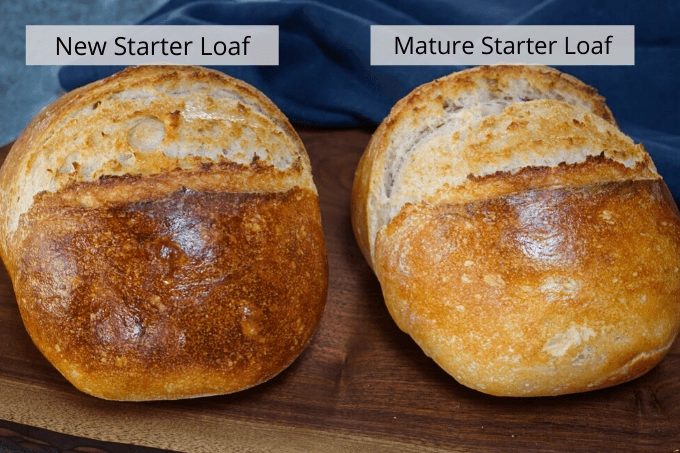
Just take a look at the way they baked up! They were both delicious. I wouldn’t have been able to tell the difference if I hadn’t been diligent in keeping them separated!
Here are recipes that use Bread Starter:
- Overnight Sourdough Bread Recipe – Perfect for Beginners and this is the recipe I used with both starters.
- Multi-Grain Wheat Bread
- Spelt Sourdough Bread
- Sourdough Sandwich Bread
- Homemade Sourdough Bread with All-Purpose Flour
Recipes to make using your leftover Starter (also called discard)
You can use your starter instead of commercial yeast. A packet of yeast equals 1 cup of your liquid starter. This article has some instructions and considerations that are helpful.
If you hate throwing away sourdough starter discard, you’re going to love these Sourdough Starter Discard recipes!
How long is Starter Discard good for?
Lots of bread bakers will stockpile their discard (depleted starter) to use in all kinds of recipes. Generally, these people are active sourdough bread bakers. I’m an on and off sourdough bread baker so I usually have to get my starter active before I bake by feeding it two or three times.
It’s o.k. to store your discard for 2 to 3 weeks in the refrigerator. Make sure that there are no signs of mold or a pink or orange discoloration before you use it. After you’ve been using a starter for a while, you’ll know what a good starter smells like. It’s a yeast or floral smell that’s not off-putting or an acidic smell.
What’s in a name?
Finally, you have to give your starter a name and tell me what it is in the comments below.
My first starter was built from some dried starter a dear friend gave me. I named her Phoenix because she was literally built from dust. My new starter is Nomad. He’s aptly named because he went on vacation with us while I was building him. He must have had a great time because he’s still very happy!
This document is constantly changing. Your questions and comments benefit all of us!
As always, I answer my own comments and emails so let me know how I can help you.

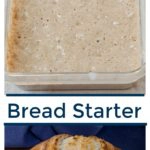

Cheryl Licata
Wednesday 21st of August 2024
Just found your recipe and going to give it a try. My question is what is your exact starter ratio for this recipe?
Julie Menghini
Sunday 25th of August 2024
It's 1:1 flour to water. I use a blend of 50% unbleached flour and 50%
Bob
Monday 16th of January 2023
Hi enjoyed your article I’m a recently retired auto technician. I am used to oil & grease on cars but have found that I enjoy baking and have found that I like the challenge of making bread. I never knew you could make your own starter for your bread. I have been using store bought yeast. But now I think I’m going to try making my own starter. My wife thinks I’m nuts but she loves the bread that I make and when my kids come back to visit they ask for some bread to take home. Thanks for the great tips
Julie Menghini
Monday 16th of January 2023
I love working with my hands as you must and find it very therapeutic. Please ask questions. I'd love to help you develop your breadmaking skills. I just made my 3rd starter. It's so much fun watching it develop (bread nerd alert). I'd suggest https://hostessatheart.com/sourdough-bread-recipe/ for your first sourdough. Many people have had a lot of luck with it. My husband and friends love homemade bread and I know your family will too!
Daniela
Sunday 30th of October 2022
Amaising very well presented all informations u may need Best of all I read before Thank you Julie
Julie Menghini
Monday 31st of October 2022
Thank you, Daniela.
Tina
Sunday 3rd of July 2022
Hi Julie, thank you for the detailed instructions. Now that I am retired, I am hoping I can tackle a sourdough starter and keep it alive (although I don't have the best track record with plants). I messed up and bought a huge bag of AP flour at the big box store without realizing it was bleached. Is it possible to use it for a starter?
Tina
Monday 4th of July 2022
@Julie Menghini, I should have looked at my new starter before I sent my first reply. It doubled in size overnight and has quite a few bubbles. Do I really need to wait two days or should I go ahead and start the daily feedings?
Tina
Monday 4th of July 2022
@Julie Menghini, Thanks for the quick response! I have a bag of sprouted whole wheat so I mixed that in 50/50. I'll let you know how it turns out
Julie Menghini
Sunday 3rd of July 2022
Yes, you can, Tina. Any flour will work. Will you be using any whole wheat with the apf? Congratulations on your retirement!
Doree
Tuesday 1st of March 2022
Hi can you convert to cups please . I always get discouraged when I have to look it up . I want to start making sourdough bread but nervous about the starter .
Julie Menghini
Wednesday 2nd of March 2022
Hi Doree! This is an easy one for you. Your flour and your water will be equal measurements(1:1). So, for 1 cup of water use 1/2 cup of wheat flour and 1/2 cup of AP flour. Or 1 cup of water to 1 cup of flour. Please let me know if you have any questions! ~Julie